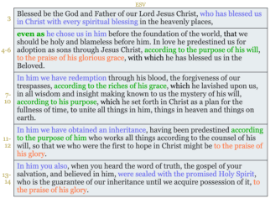Lesson 4 | Links in a chain: connecting the parts
Implied connections
You may have noticed in the examples from the previous step that there is not always a specific word used to link each idea to the others. It is not that there are no links at these points but that the links are simply implied. This actually happens more often than you might at first suppose.
For example, it is very common to leave off one side of a two-word connection. One half implies the other half:
If these qualities are yours and are increasing, [then] they keep you from being ineffective or unfruitful… —2 Peter 1:8b ESV If you practice these qualities [then] you will never fall. —2 Peter 1:10b ESV Like clouds and wind without rain [so also] is a man who boasts of a gift he does not give. —Proverbs 25:14 ESV
Or consider the exhortation:
Beloved, do not imitate evil but imitate good. Whoever does good is from God; whoever does evil has not seen God. —3 John 1:11 ESV
The initial exhortation has two elements placed in contrast: “do not imitate evil but imitate good.” But the three statements separated by the punctuation have no connectors at all. Nevertheless, the implied connections are able to be discerned:
Beloved, do not imitate evil but imitate good. [Because] [on the one hand] whoever does good is from God; [while on the other hand] whoever does evil has not seen God. —3 John 1:11 ESV
Many times, the absence of an explicit connector leaves the reader to give thoughtful consideration as to what connection is, in fact, intended. In such cases, we need to ask, “Why is the author saying these things?” “How do these parts relate to one another?” Furthermore, the author may use other elements to point to the links he intends. For example, carefully read Ephesians 1:3-14 below. I have already split the text into five smaller units. But notice that only the second unit has a explicit connector: even as. As you read over this passage two or three times, what patterns, words, or phrases emerge as indications for how these parts are linked in Paul’s thinking? Try to identify three different patterns before clicking on the link to my observations below.
Blessed be the God and Father of our Lord Jesus Christ, who has blessed us in Christ with every spiritual blessing in the heavenly places, even as he chose us in him before the foundation of the world, that we should be holy and blameless before him. In love he predestined us for adoption to himself as sons through Jesus Christ, according to the purpose of his will, to the praise of his glorious grace, with which he has blessed us in the Beloved. In him we have redemption through his blood, the forgiveness of our trespasses, according to the riches of his grace, which he lavished upon us, in all wisdom and insight making known to us the mystery of his will, according to his purpose, which he set forth in Christ as a plan for the fullness of time, to unite all things in him, things in heaven and things on earth. In him we have obtained an inheritance, having been predestined according to the purpose of him who works all things according to the counsel of his will, so that we who were the first to hope in Christ might be to the praise of his glory. In him you also, when you heard the word of truth, the gospel of your salvation, and believed in him, were sealed with the promised Holy Spirit, who is the guarantee of our inheritance until we acquire possession of it, to the praise of his glory. —Ephesians 1:3-14 ESV
 Verbal links in Ephesians 1:3-10
Verbal links in Ephesians 1:3-10Click here to see my observations of the links that join this passage together.